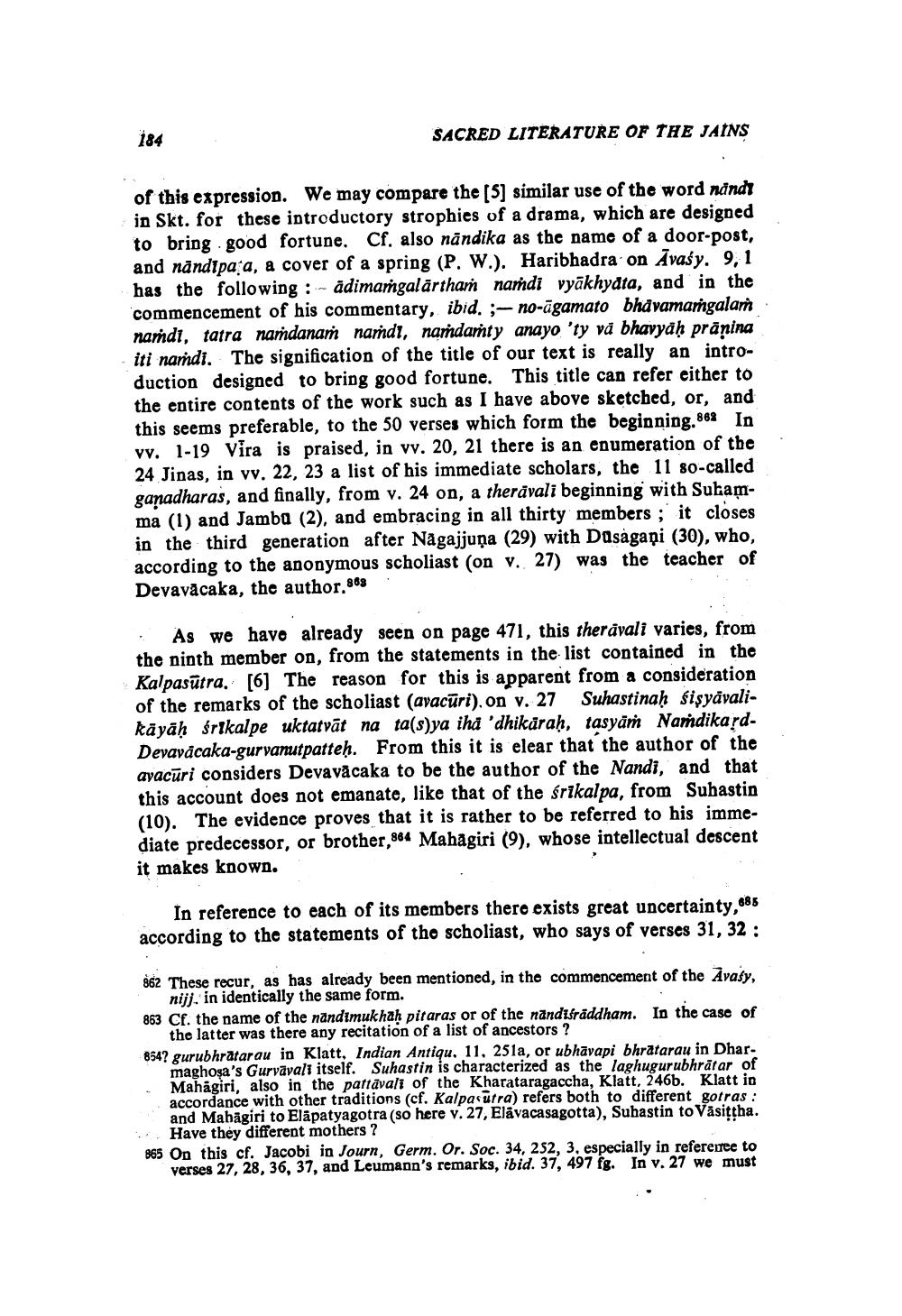________________
184
SACRED LITERATURE OF THE JAINS
of this expression. We may compare the [5] similar use of the word nandi in Skt. for these introductory strophies of a drama, which are designed to bring good fortune. Cf. also nandika as the name of a door-post, and nändipaa, a cover of a spring (P. W.). Haribhadra on Āvašy. 9,1 has the following: - adimaṁgalärthań nardi vyākhydta, and in the commencement of his commentary, ibid. ;- no-āgamato bhavamangalam nardi, tatra nadanam nardi, namdarty anayo 'ty và bhavyaḥ pranina iti naṁdi. The signification of the title of our text is really an introduction designed to bring good fortune. This title can refer either to the entire contents of the work such as I have above sketched, or, and this seems preferable, to the 50 verses which form the beginning. 862 In vv. 1-19 Vira is praised, in vv. 20, 21 there is an enumeration of the 24 Jinas, in vv. 22, 23 a list of his immediate scholars, the 11 so-called ganadharas, and finally, from v. 24 on, a theravali beginning with Sukamma (1) and Jambu (2), and embracing in all thirty members; it closes in the third generation after Någajjuņa (29) with Dasagapi (30), who, according to the anonymous scholiast (on v. 27) was the teacher of Devavācaka, the author. 888
. As we have already seen on page 471, this theravali varies, from the ninth member on, from the statements in the list contained in the Kalpasūtra. [6] The reason for this is apparent from a consideration of the remarks of the scholiast (avacūri), on v. 27 Suhastinaḥ śişyavalikāyāḥ śrikalpe uktatvāt na ta(s)ya iha 'dhikaraḥ, tasyāṁ Nardikard. Devavăcaka-gurvanutpatteh. From this it is elear that the author of the ayacūri considers Devavācaka to be the author of the Nandi, and that this account does not emanate, like that of the srikalpa, from Subastin (10). The evidence proves that it is rather to be referred to his immediate predecessor, or brother,864 Mahagiri (9), whose intellectual descent it makes known.
In reference to each of its members there exists great uncertainty, 686 according to the statements of the scholiast, who says of verses 31, 32 :
862 These recur, as has already been mentioned, in the commencement of the Avasy,
nijj, in identically the same form. 863 Cf. the name of the nandtmukhah pitaras or of the nandi fräddham. In the case of
the latter was there any recitation of a list of ancestors ? 8542 gurubhratarau in Klatt, Indian Antiqu, 11, 251a, or ubhāvapi bhratarau in Dhar
maghosa's Gurvāvali itself. Suhastin is characterized as the laghugurubhratar of Mahagiri, also in the pattāvali of the Kharataragaccha, Klatt, 246b. Klatt in accordance with other traditions (cf. Kalpasutra) refers both to different gotras : and Mabagiri to Eläpatyagotra (So here v. 27, Elávacasagotta), Suhastin to Väsittha.
Have they different mothers ? 865 On this cf. Jacobi in Journ, Germ. Or. Soc. 34, 252, 3, especially in refererree to
verses 27, 28, 36, 37, and Leumann's remarks, ibid. 37, 497 fg. In v. 27 we must




